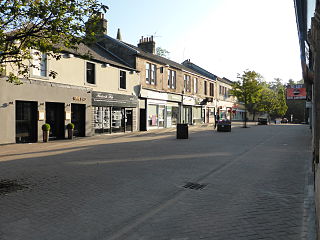
Milngavie is a town in East Dunbartonshire, Scotland and a suburb of Glasgow. It is on the Allander Water, at the northwestern edge of Greater Glasgow, and about ten kilometres from Glasgow city centre. It neighbours Bearsden. Milngavie is a commuter town, with much of its working population travelling to Glasgow to work or study. The town is served by Milngavie railway station on the North Clyde Line of the SPT rail network, which links it to Central Glasgow.
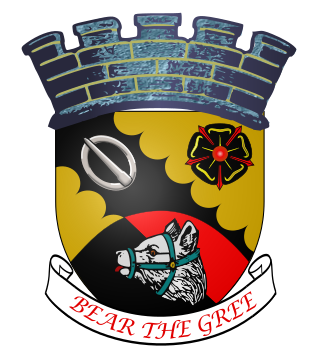
Bearsden is a town in East Dunbartonshire, Scotland, on the northwestern fringe of Greater Glasgow, approximately 6 miles (10 km) from the city centre.

Knightswood is a suburban district in Glasgow, containing three areas: Knightswood North or High Knightswood, Knightswood South or Low Knightswood, and Knightswood Park. It has a golf course and park, and good transport links with the rest of the city. Garscadden and Scotstounhill railway stations serve Low Knightswood while Westerton station serves High Knightswood. Knightswood is directly adjoined by the Anniesland, Blairdardie, Drumchapel, Garscadden, Jordanhill, Netherton, Scotstoun, Scotstounhill and Yoker areas of Glasgow, and by Bearsden in the north.
The United Presbyterian Church (1847–1900) was a Scottish Presbyterian denomination. It was formed in 1847 by the union of the United Secession Church and the Relief Church, and in 1900 merged with the Free Church of Scotland to form the United Free Church of Scotland, which in turn united with the Church of Scotland in 1929. For most of its existence the United Presbyterian Church was the third largest Presbyterian Church in Scotland, and stood on the liberal wing of Scots Presbyterianism. The Church's name was often abbreviated to the initials U.P.

Kirkintilloch is a town and former barony burgh in East Dunbartonshire, Scotland. It lies on the Forth and Clyde Canal and on the south side of Strathkelvin, about 8 miles (13 km) northeast of central Glasgow. Historically part of Dunbartonshire, the town is the administrative home of East Dunbartonshire council area, its population in 2009 was estimated at 19,700 and its population in 2011 was 19,689.

Hillhead High School is a day school in Glasgow, Scotland, on Oakfield Avenue, neighbouring the University of Glasgow.

Wellington Church is a congregation and parish church of the Church of Scotland, serving part of the Hillhead area of Glasgow, Scotland. The building is located on University Avenue, Glasgow, opposite the University of Glasgow.
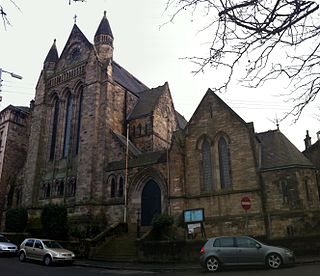
St. Luke's Greek Orthodox Cathedral is a cathedral of the Greek Orthodox Church in the Dowanhill district of Glasgow, Scotland.
Blythswood Hill, centred on Blythswood Square, is an area of central Glasgow, Scotland. It extends from the west edge of Buchanan Street to Gordon Street and Bothwell Street, Charing Cross, Sauchiehall Street and Garnethill. Developed from 1800 onwards, its Georgian and Victorian architecture is a Conservation Area. It started as the "Magnificent New Town of Blythswood", becoming a part of the city-centre's business and social life.
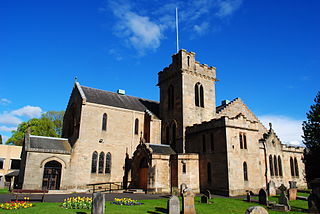
New Kilpatrick, is an ecclesiastical Parish and former Civil Parish in Dunbartonshire. It was formed in 1649 from the eastern half of the parish of Kilpatrick, the western half forming Old Kilpatrick. New Kilpatrick is also a disused name for the town of Bearsden.

Bon Accord Free Church is a congregation of the Free Church of Scotland in Aberdeen.
Galashiels Baptist Church is located in the town of Galashiels, Scottish Borders, Scotland, UK. It was founded in 1804 and is affiliated to the Baptist Union of Scotland.

St. John's Renfield Church is a parish church of the Church of Scotland, serving Kelvindale in the west end of Glasgow, Scotland. It is within the Church of Scotland's Presbytery of Glasgow.

Kelvinside Hillhead Parish Church, originally Hillhead Parish Church, is a parish church of the Church of Scotland, serving the Hillhead and Kelvinside areas of Glasgow, Scotland. It is within the Church of Scotland's Presbytery of Glasgow.

Glasgow High Kelvinside , often abbreviated to GHK, is an amateur rugby union club in Glasgow, Scotland. They currently play in Scottish National League Division One.

Thomas Lennox Watson, FRIBA, was a Scottish architect and interior designer. Born in Glasgow, he submitted designs for the city's City Chambers (1880) and Kelvingrove Art Gallery (1892) competitions, but was unsuccessful.
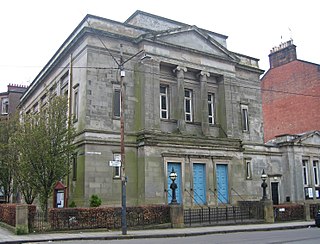
Hillhead Baptist Church is a Baptist church in the west end of Glasgow, Scotland. It is affiliated with the Baptist Union of Scotland. It has operated for over 125 years, one of 164 active Baptist churches in Scotland in the early twenty-first century.

Reverend Robert Guy Ramsay (1895–1976) was a twentieth-century Scottish Baptist minister and author, most closely associated with Hillhead Baptist Church, Glasgow, Scotland. Rev Guy Ramsay was President of the Baptist Union of Scotland during the late 1940s.
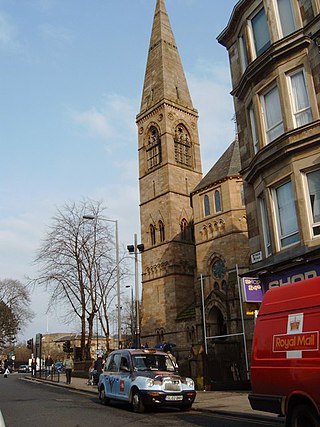
Òran Mór is a theatre, restaurant, entertainment and music venue in Glasgow. From 1862 until 1978 the building was the Kelvinside Parish Church before becoming redundant and then converted into an entertainment venue in 2004.

Vera Mary Muir Kenmure born Vera Mary Muir Findley was a British Congregational minister. She was the first woman minister ordained in Scotland to be in charge of a church. She founded her own church in Partick after objections were raised, by some of her congregation, to her becoming a mother while still a minister.




















